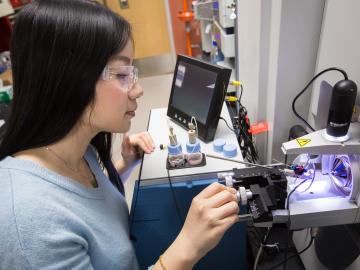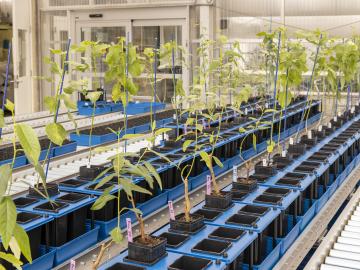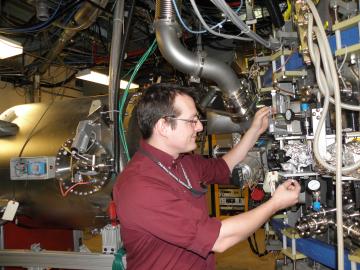
Filter News
Area of Research
- (-) Energy Science (66)
- (-) Nuclear Science and Technology (11)
- Advanced Manufacturing (6)
- Biological Systems (2)
- Biology and Environment (67)
- Computational Engineering (2)
- Computer Science (5)
- Electricity and Smart Grid (1)
- Energy Frontier Research Centers (1)
- Functional Materials for Energy (1)
- Fusion and Fission (24)
- Fusion Energy (15)
- Materials (91)
- Materials for Computing (9)
- Mathematics (1)
- National Security (32)
- Neutron Science (32)
- Quantum information Science (4)
- Supercomputing (45)
News Topics
- (-) Bioenergy (26)
- (-) Clean Water (8)
- (-) Composites (17)
- (-) Cybersecurity (9)
- (-) Fusion (9)
- (-) Machine Learning (7)
- (-) Nanotechnology (8)
- (-) Physics (3)
- 3-D Printing/Advanced Manufacturing (82)
- Advanced Reactors (15)
- Artificial Intelligence (8)
- Big Data (5)
- Biology (11)
- Biomedical (8)
- Biotechnology (4)
- Buildings (38)
- Chemical Sciences (14)
- Computer Science (27)
- Coronavirus (13)
- Critical Materials (9)
- Energy Storage (71)
- Environment (54)
- Exascale Computing (2)
- Fossil Energy (2)
- Frontier (2)
- Grid (39)
- High-Performance Computing (6)
- Hydropower (3)
- Isotopes (6)
- Materials (35)
- Materials Science (29)
- Mathematics (2)
- Mercury (3)
- Microelectronics (1)
- Microscopy (8)
- Molten Salt (5)
- National Security (5)
- Neutron Science (15)
- Nuclear Energy (41)
- Partnerships (12)
- Polymers (11)
- Quantum Science (2)
- Security (6)
- Simulation (4)
- Space Exploration (7)
- Statistics (1)
- Summit (4)
- Transportation (66)
Media Contacts

The inside of future nuclear fusion energy reactors will be among the harshest environments ever produced on Earth. What’s strong enough to protect the inside of a fusion reactor from plasma-produced heat fluxes akin to space shuttles reentering Earth’s atmosphere?

Scientists at Oak Ridge National Laboratory and Ohio State University discovered a new microbial pathway that produces ethylene, providing a potential avenue for biomanufacturing a common component of plastics, adhesives, coolants and other

Oak Ridge National Laboratory researchers have developed artificial intelligence software for powder bed 3D printers that assesses the quality of parts in real time, without the need for expensive characterization equipment.

Scientists at the Department of Energy’s Oak Ridge National Laboratory have a powerful new tool in the quest to produce better plants for biofuels, bioproducts and agriculture.

Oak Ridge National Laboratory researchers have developed a machine learning model that could help predict the impact pandemics such as COVID-19 have on fuel demand in the United States.

Lithium, the silvery metal that powers smart phones and helps treat bipolar disorders, could also play a significant role in the worldwide effort to harvest on Earth the safe, clean and virtually limitless fusion energy that powers the sun and stars.

Five researchers at the Department of Energy’s Oak Ridge National Laboratory have been named ORNL Corporate Fellows in recognition of significant career accomplishments and continued leadership in their scientific fields.

Scientists at ORNL used neutron scattering and supercomputing to better understand how an organic solvent and water work together to break down plant biomass, creating a pathway to significantly improve the production of renewable

Researchers at Oak Ridge National Laboratory developed a method that uses machine learning to predict seasonal fire risk in Africa, where half of the world’s wildfire-related carbon emissions originate.

Juergen Rapp, a distinguished R&D staff scientist in ORNL’s Fusion Energy Division in the Nuclear Science and Engineering Directorate, has been named a fellow of the American Nuclear Society


